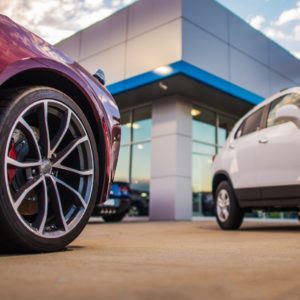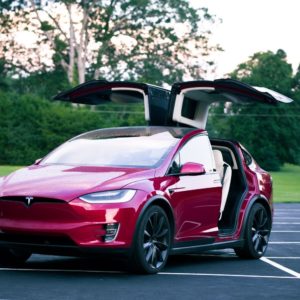The price tag of a brand-new car rises with each passing year. Surely, dealerships have been raking in the cash? How much does a car dealer make whenever they successfully close a deal on a new car? And how can you use this knowledge to secure the best deal for yourself?
How Much Do Dealerships Make on New Cars?
When a dealer successfully sells a new vehicle, they usually earn less than 8.7% of the invoice price. The manufacturer takes the lion’s share of the money paid for the car.
The invoice price is what car dealers (and other retailers that directly sell to customers) pay the manufacturer for the product. It’s different from the manufacturer’s suggested retail price (MSRP), which is the price the carmaker advises the dealer to sell the product. MSRP is better known as sticker price.
You can ask your dealership for a copy of the invoice price report for your new car. The document records the profit the dealer earned from the sale. It also breaks down the fees, finance rates, and lease rates to give you a better idea of the specifics you’re paying for. The report will also cover local incentives applied to your purchase.
What Is the Dealer Margin?
The dealer margin is the difference between the car’s invoice price and its sale price. It’s usually the direct profit made by the car dealership on selling a new car.
How Do Car Dealerships Earn Their Keep?
New car sales account for roughly 30% of the gross profits of a typical car dealership. The rest of the dealer’s earnings come from different sources of income.
Maintenance and Service Fees
Car dealers get most of their earnings from the fees they charge for maintaining and servicing vehicles purchased from them. If the car develops a mechanical issue, its owner often returns it to the dealership that sold it for repairs.
Dealerships can repair and replace old and damaged parts likebatteries,brake pads, andwindshield wiper blades.
Volume Bonus
Have you ever wondered why dealers loudly insist they’re taking a loss when selling a car below invoice cost to you?
They’re not lying about losing money on the sale of discounted vehicles. However, they’re leaving out the part where they receive volume bonuses from the car manufacturer that might offset the loss of profit.
A volume bonus is a reward incentive for dealers to meet or surpass specific sales targets within a set period. While it often takes the form of cash, it might also include non-monetary rewards like paid vacation trips.
Volume bonuses are usually tied to the car dealership’s sales volume or revenue goals. The more cars sold or the higher the revenue goals met, the bigger the volume bonus.
Dealer Holdback
Car dealerships might also receive a dealer holdback when they sell a new vehicle. The dealer holdback is a percentage of either the MSRP or invoice price, and the manufacturer pays it to the dealer after a successful sale.
Dealer holdbacks provide several benefits to car dealerships. First, they open the door for loans. Car dealerships pay for the cars they sell to customers with loans based on an invoiced amount. The bigger the invoice, the bigger the loan they can take. Anything that increases the invoice will increase the loan, and the dealer holdback is part of the invoice.
Second, dealer holdbacks can improve the dealership’s earnings by inflating the cost of the business. Sales personnel receive commissions according to the gross profit made on each sale. Holdbacks reduce the gross profit, which in turn decreases the commissions paid to the salespersons.
Last but not least, dealer holdbacks allow dealerships to offer and sell cars at invoice prices or close to such price tags while still earning a profit.
Other Financial Assistance From Car Manufacturers
Dealer holdbacks are the most common way for the manufacturers to help dealerships keep the lights on. There are other types of credit and holdbacks available, some publicly known and others hidden from the public. However, they all reduce the vehicle’s net cost to the dealer.
Examples of manufacturer-provided financial assistance include:
- Advertising credits
- Flooring assistance
- Floor interest reserve
- Floor plan allowance
- Transfer balance
- Wholesale reserve
- Wholesale credits
Other Income Sources
Other sources of income for car dealerships include:
- Auto insurance
- Financing
- Car add-ons
- Extended warranty contracts
What are the Usual Expenses of a Car Dealership?
Car dealerships use their earnings to pay for various operating costs, such as the following:
- Advertisement fees
- Building maintenance and repair
- Salaries for the employees
- Showroom lease
Tips on Getting Good Deals on New Cars
You now know that dealerships only get a slim profit margin on new car sales. However, you can still get a good deal from them.
It’s recommended to ask for a price between 3% and 8% above the invoice price, somewhere between the invoice price and the MSRP. Most dealers will agree to such a deal because they get enough profit from it.
Furthermore, avoid bringing up dealer holdbacks during negotiations. Car dealerships are very protective of that particular source of income. If you want to haggle over prices, focus on the incentives instead of the holdbacks.
Hopefully, you can get a fair and good price on your new car. If that’s not up to your speed, consider getting an older vehicle. There are many unsold new cars that the car dealership might offer at discounted prices.
Any information provided on this Website is for informational purposes only and is not intended to replace consultation with a professional mechanic. The accuracy and timeliness of the information may change from the time of publication.




















